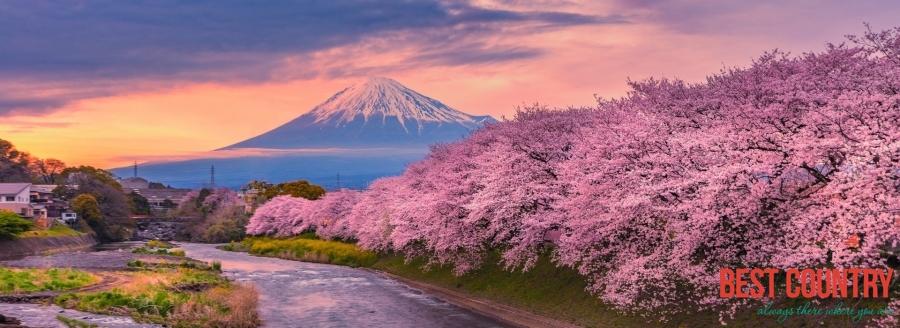Climate of Japan

Japan is generally a rainy country with high humidity. Because of its wide range of latitude, Japan has a variety of climates, with a range often compared to that of the east coast of North America, from Nova Scotia to the U.S. state of Georgia. Tokyo is at about 35 degrees north latitude, comparable to that of Tehran, Athens, or Las Vegas. The generally humid, temperate climate exhibits marked seasonal variation celebrated in art and literature, as well as regional variations ranging from cool in Hokkaidō to subtropical in Kyūshū. Climate also varies with altitude and with location on the Pacific Ocean or on the Sea of Japan. Northern Japan has warm summers but long, cold winters with heavy snow. Central Japan has hot, humid summers and short winters, and southwestern Japan has long, hot, humid summers and mild winters.
Two primary factors influence Japan's climate: a location near the Asian continent and the existence of major oceanic currents. The climate from June to September is marked by hot, wet weather brought by tropical airflows from the Pacific Ocean and Southeast Asia. These airflows are full of moisture and deposit substantial amounts of rain when they reach land. There is a marked rainy season, beginning in early June and continuing for about a month. It is followed by hot, sticky weather. Five or six typhoons pass over or near Japan every year from early August to early September, sometimes resulting in significant damage. Annual precipitation, which averages between 1,000 and 2,000 mm (39.4 and 78.7 in), is concentrated in the period between June and September. In fact, 70 to 80 percent of the annual precipitation falls during this period. In winter, a high-pressure area develops over Siberia, and a low-pressure area develops over the northern Pacific Ocean. The result is a flow of cold air eastward across Japan that brings freezing temperatures and heavy snowfalls to the central mountain ranges facing the Sea of Japan, but clear skies to areas fronting on the Pacific.
Two major ocean currents affect this climatic pattern: the warm Kuroshio Current (Black Current; also known as the Japan Current); and the cold Oyashio Current (Parent Current; also known as the Okhotsk Current). The Kuroshio Current flows northward on the Pacific side of Japan and warms areas as far north as Tokyo; a small branch, the Tsushima Current, flows up the Sea of Japan side. The Oyashio Current, which abounds in plankton beneficial to coldwater fish, flows southward along the northern Pacific, cooling adjacent coastal areas. The meeting point of these currents at 36 north latitude is a bountiful fishing ground.
Late June and early July are a rainy season—except in Hokkaidō—as a seasonal rain front or baiu zensen stays above Japan. In summer and early autumn, typhoons, grown from tropical depressions generated near the equator, attack Japan with furious rainstorms.
Its varied geographical features divide Japan into six principal climatic zones.
Hokkaidō: Belonging to the cool temperate zone, Hokkaidō has long, cold winters and cool summers. Precipitation is not great.
Sea of Japan: The northwest seasonal wind in winter gives heavy snowfalls. In summer it is less hot than in the Pacific area but sometimes experiences extreme high temperatures due to the foehn wind phenomenon.
Central Highland: A typical inland climate gives large temperature differences between summers and winters and between days and nights. Precipitation is not large throughout the year.
Seto Inland Sea: The mountains in the Chūgoku and Shikoku regions block the seasonal winds and bring mild climate and many fine days throughout the year.
Pacific Ocean: Winters are cold, with little snowfall, and summers are hot and humid due to the southeast seasonal wind.
Southwest Islands: This zone has a subtropical climate with warm winters and hot summers. Precipitation is very high, and is especially affected by the rainy season and typhoons.
The warmest winter temperatures are found in the Nanpo and Bonin Islands, which enjoy a tropical climate due to the combination of latitude, distance from the Asian mainland, and warming effect of winds from the Kuroshio, as well as the Volcano Islands (at the latitude of the southernmost Ryūkyūs, 24° N.).
As an island nation, Japan has a long coastline. A few prefectures are landlocked: Gunma, Tochigi, Saitama, Nagano, Yamanashi, Gifu, Shiga, and Nara. As Mt. Fuji provides rain shadow effects in Yamanashi it has the least rainfall in Japan, which still exceeds 1,000 mm annually. The others all have coasts on the Pacific Ocean, Sea of Japan, Seto Inland Sea or have a body of salt water connected to them. Two prefectures—Hokkaidō and Okinawa—are composed entirely of islands.
The hottest temperature ever measured in Japan, 40.9 °C (105.6 °F), occurred in Tajimi, Gifu on August 16, 2007.